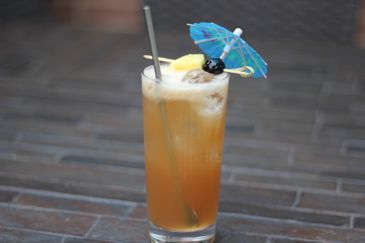A Rum Primer For National Rum Day
By Paul Leddy in Food on Aug 16, 2013 4:20PM

The Planter's Punch tiki cocktail dates back to the 1950's and contains 3 different types of rum.
For those who have not looked through bleary eyes at the bottom of one of the bar's specially made tiki mugs, the cocktail bar is the brainchild of Paul McGee and is part of the Lettuce Entertain You empire. It is located in the basement of Bub City (with the entrance located in the alley behind the restaurant). The decor pays homage to the tiki bars that proliferated in the United States from the 1930s to the 1960s. The drinks, however, are well-crafted, well-orchestrated and beautifully garnished. There are a total of 20 cocktails offered that utilize 15 different rums (from the 150 that McGee stocks behind his bar). Many of the cocktails incorporate 2 or 3 different types of rum in one drink.
Staring at a list of cocktails that include ingredients like "Guyanese rum" or "Rhum Agricole" can be intimidating to the rum novice. Today, on this National Rum Day, we offer an introduction to rum and a brief explanation of some of the rum producing areas that are seen on the Three Dots and a Dash menu and other rum-heavy menus around town.
Most rum is made from the byproduct of sugar production: molasses. Rum's flavors and unique characteristics come from its terroir—or the soil and climate that the sugar cane is grown. On a recent Airwaves of Bacon podcast, rum expert Ed Hamilton said that rum is "the most diverse of all the distilled spirits with a huge palate of flavors and styles."
On the simplest level, rum can be classified in three main styles: light, aged, and dark.
Another category of rums worth mentioning (especially for its use in many tiki drinks) are the rums that are made directly from sugar cane juice instead of molasses. In Martinique, this type of rum is called Rhum Agricole. In Brazil, it is called Cachaça. In Haiti, Rhum Barbancourt also starts with fermented sugar cane juice. Just like wine, the flavor profiles among the rum-producing countries in the Caribbean and Central South America can vary significantly.
The home bartender may not want to stock 15 different rums for your tiki parties. To save you trouble, here are our favorite rums in each category. We also include the country where it is produced. Now you can stock your home bar fairly well without building a whole rum closet into your wall.
Light Rum - Brugal Extra Dry (Domincan Republic), Banks 5 Island (Combination of Trinidad, Jamaica, Guyana, Barbados and Java),
Amber/Aged- Angostura 1919 (Trinidad), El Dorado 5 year (Guayna), Cockspur (Barbados), Appleton Estate VX (Jamaica)
Dark/Overproof - Myers (Jamaica), Lemon Hart 151 Demerara (Guyana), Cruzan Blackstrap (US Virgin Islands)
Rhum Agricole/sugar cane rums - La Favorite Rhum Agricole Blanc (Martinique), Neisson Rhum Agricole Blanc (Martinque); Barbancourt 3 Star (Haiti)
Experiment and mix-and-match rums if a drink calls for more than one. As long as you have the right type, you'll get something close to the right flavor, and when you're done with one rum, check out another. You'll never run out.
Why use two or three types of rum in a single drink drink? McGee cites a quote that is attributed to the original tiki master, Don the Beachcomber: "What one rum can’t do, three rums can."
An experiment we did with Sable bartender Mike Ryan beautifully illustrated this point. Ryan poured 4 different rums in separate glasses. He poured a light rum from the Dominican Republic, an aged rum from Guyana, a dark rum from Jamaica and a rhum agricole from Martinique. We took a sip, noting the unique flavors of each rum. At the end of the tasting, Ryan combined the remaining rums together into one glass and instructed us to taste it. The resulting mix of rums had no dominating flavors, but mixed harmoniously together to form a whole new flavor.
While the world of rum can be intimidating for beginners, once you play around with the different styles and see how much fun this category of spirit can be, you will be mixing up cocktails like the "Planter's Punch" at home. Although, we think the best education in rum and spirits is sitting down at your favorite cocktail bar and doing your own research.
Planter’s Punch (Dick Moano version)
2 ounces fresh lime juice
1 ounce grapefruit juice
1 ounce gold Puerto Rican rum
1 ounce dark Jamaican rum
1 ounce Rhum Barbancourt
1 ounce honey mix (1:1 honey to water)
0.25 teaspoon grenadine
2 dashes Angostura bitters
Shake well with plenty of ice cubes. Pour unstrained into a tall glass. Garnish with a pineapple slice and cocktail cherry.
Original drink by Dick Moano, circa 1950s. (The Aku-Aku in Las Vegas, the Islander in Beverly Hills, and the Cambodian Room in Palm Springs numbered among Moano’s bartending gigs during the heyday of Polynesian Pop.) Adapted from Jeff Berry, Beachbum Berry’s Intoxica. (San Jose: SLG Publishing, 2002) p. 71. From Beachbum Berry's Tiki+ for iPad.
***UPDATE: An earlier version of the story stated incorrectly that Paul McGee came up with the quote "What one rum can’t do, three rums can". Although it is a mystery when and where it was first said, the quote is attributed to Ernest Raymond Beaumont Gantt (aka "Don the Beachcomber")